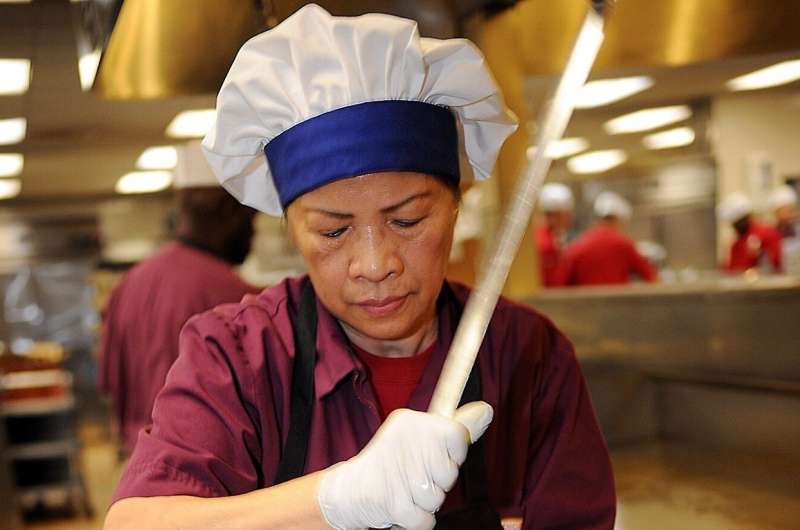This article has been reviewed according to Science X's editorial process and policies. Editors have highlighted the following attributes while ensuring the content's credibility:
fact-checked
trusted source
proofread
Immigration slowed in COVID-19 pandemic, but migrant jobs not filled by U.S.-born

A prevailing narrative about immigration is that migrants displace U.S.-born residents in the workforce, but new research from University of California, Davis, economists shows that's not the case.
The study, published in the Journal of Population Economics, details how the COVID-19 pandemic led to a decrease in immigration to the U.S. and how jobs often filled by migrants were not filled by U.S.-born residents.
"We found that this drop in immigrants corresponded also to a drop in employment in some specific types of occupations, including accommodation and food services, retail trade, non-durable goods manufacturing, and health care and social assistance," said Giovanni Peri, a professor of economics and director of the UC Davis Global Migration Center. "The question is, 'Did Americans move into those sectors and into those states that experienced the biggest drop in immigrants?' And the answer is, 'no.'"
Aggregating data from the U.S. Census Bureau's Current Population Survey and the U.S. Bureau of Labor Statistics' Job Openings and Labor Turnover Survey, the study, according to Peri, has the potential to change prejudiced views of immigration by providing data and facts.
Immigration can bolster the labor market but "changing the attitude toward immigration starts with changing our understanding and our knowledge of the facts," Peri said.
COVID-19 pandemic adds to immigration slowdown
Before the COVID-19 pandemic, immigration to the U.S. already faced a slowdown due to policies implemented by the Trump administration. But the pandemic halted international travel, leading to a drastic decline in the net growth of working-age (18–65 years old) foreign-born individuals.
Between May 2010 and May 2019, this population segment grew by an average of 660,000 individuals per year. Between May 2019 and June 2022, that population segment only grew by a total of 300,000, implying a working-age, foreign-born population gap of 1.65 million.
This decline in immigration affected different states in different ways.
"There are some states in which up to 30% to 35% of the population are immigrants, like in California, New York or Texas," Peri said. "And then there are some states where there are very few immigrants, like Wyoming and Alabama."
In four immigrant-heavy (more than 20% of represented employment) job sectors—including accommodation and food services, retail trade, non-durable goods manufacturing, and health care and social services—employment dropped at least 10% during 2020. The most affected job sector—accommodation and food services—experienced a 30% drop.
"This study isn't saying that the immigration drop was the only explanation for job openings," clarified Peri, noting that early retirement ushered in by the COVID-19 pandemic also contributed to the drop-off in employment. "But because there was already this decline in U.S. workers, immigrant loss was especially consequential."
Help wanted
With such a steep drop-off in immigration, Peri and his co-author, Reem Zaiour, a doctoral candidate in the Department of Economics, wondered if Americans would fill the increasing number of open jobs by moving to states that historically have high foreign-born populations.
It turns out that the effect on such mobility was negligible.
"Jobs were out there, but they were not filled," said Peri, noting that myriad reasons could account for this, including education level and age. "So, immigrants fill jobs that without them would be essentially unfilled."
While immigration and employment appear to be bouncing back to their pre-2020 trends, Peri said the study provides a window into how declining immigration can affect the overall U.S. labor market and highlights the need for immigrants.
"My research on the economics of immigration is deeply motivated by this idea that immigration is an extraordinary asset for the U.S.," Peri said. "The U.S. is an aging society; the population is slowing down; and innovation and changes come from new ideas and new people."
Peri presented the findings from this research in San Diego on Aug. 11 at the Institute for Humane Studies event "Downstream Effects of COVID-19 Restrictions on Immigration."
More information: Giovanni Peri et al, Changes in international immigration and internal native mobility after COVID-19 in the USA, Journal of Population Economics (2023). DOI: 10.1007/s00148-023-00972-y
Provided by UC Davis



















